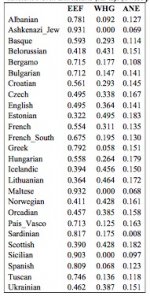Alan
Elite member
- Messages
- 2,517
- Reaction score
- 450
- Points
- 0
- Ethnic group
- Kurdish
- Y-DNA haplogroup
- R1a1a1
- mtDNA haplogroup
- HV2a1 +G13708A
The thin nose is common enough yes but I wasn't focused on that, the subject was the crania.Alan,
to my knowledge, and as I see the 1922 refuggees in Greece,
an anatolian is not like the links,
although close but not,
minor asians should have thin nose, and curved down.
The "Anatolian" you are talking about are the Pontic Greeks from Northeast "Anatolia" which in fact isn't Anatolia but the Transcaucasus. It is a local variant/phyciscal process that took place and is often seen around Armenia (the Dinarization process). Still most Pontic Greeks are mesocephalic also though and other Pontic Greeks I have seen look quite like the people I have posted. Also I spoke of the average, there is of course variation but the avergae is mesocephalic.
It's not even the Nose, I was hinting towards the crania. The Hawk like appearance or slightly convex noses are more a CHG thing yes, but the point is that they were mesocephalic.
The "anatolians" in Greece you mean are definitely the Pontic Greeks, they are known for very thin noses. People from the Northeast are generally known for this.
See here.

Also take in mind I am speaking of the average, which indicates that there is variation.
In this video you can see well what I mean, the people are predominantly mesocephalic by crania
Last edited:


